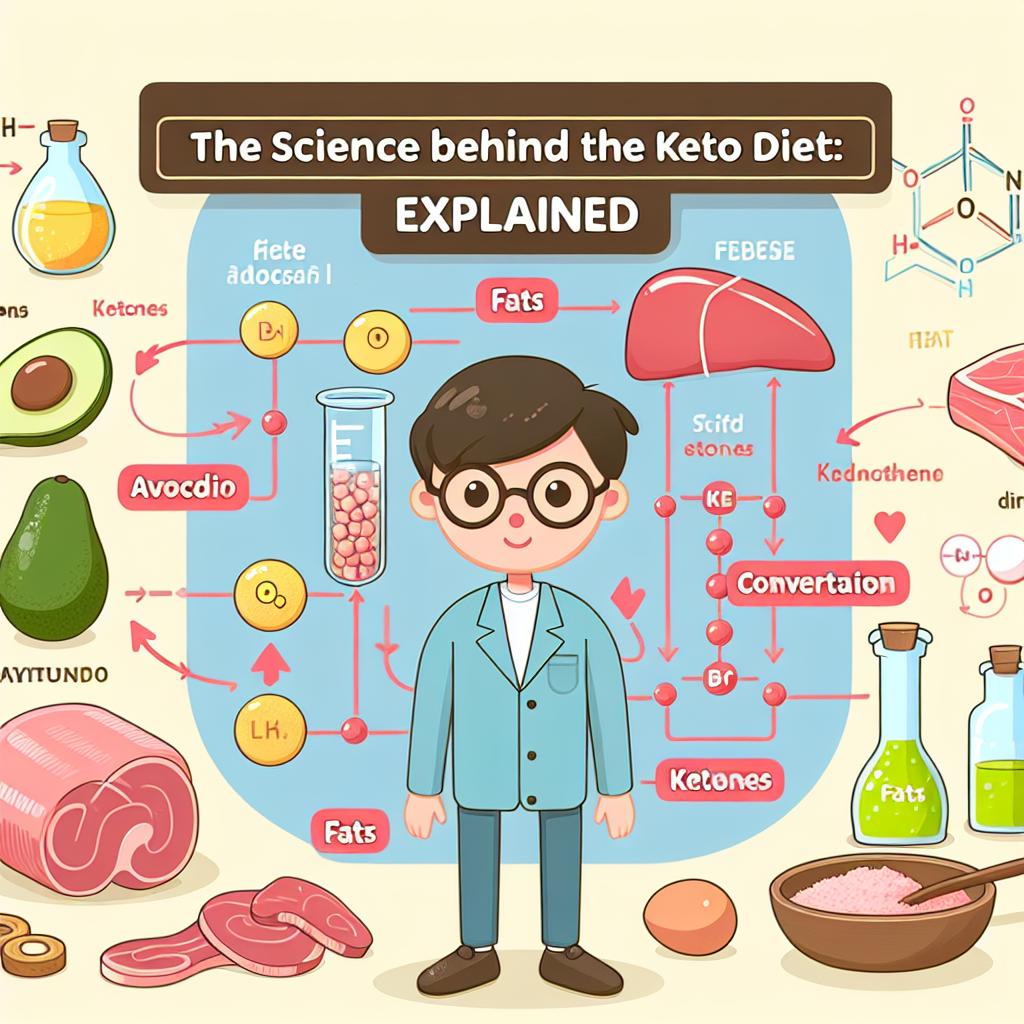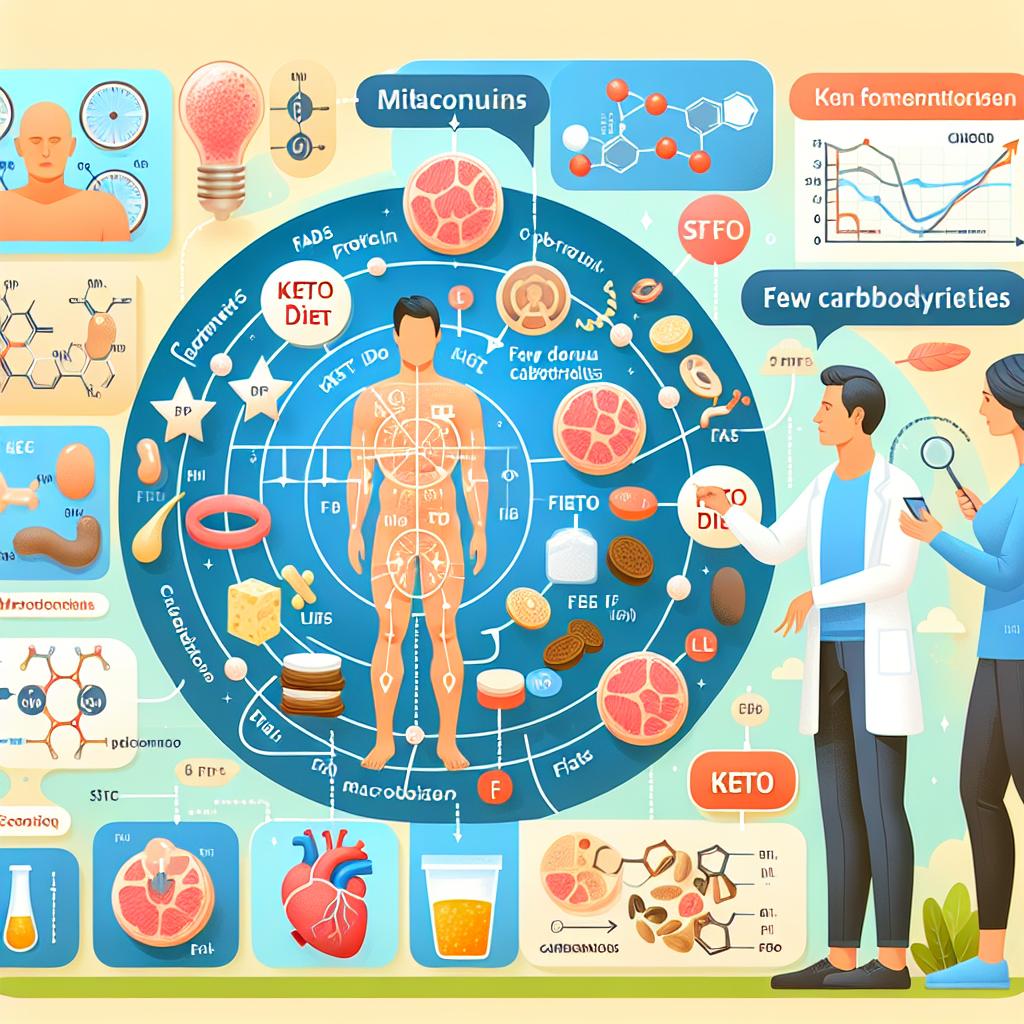This post may contain affiliate links which means I may receive a commission for purchases made through links. Learn more on my Private Policy page.
The Science Behind the Keto Diet: Explained
In a world overflowing with dietary fads and fleeting trends, the ketogenic diet emerges as a curious yet steadfast contender, often sparking intrigue and enthusiastic discussions at dinner tables and gym sessions alike. You may have heard whispers of its magical powers—of shedding stubborn pounds and energizing the mind—but have you ever delved into the science that propels this high-fat, low-carb lifestyle? Welcome to a friendly exploration of the keto diet, where we’ll unravel the intriguing biology behind this popular eating plan. From the underlying metabolic processes to its impact on health and wellness, let’s journey together through the fascinating world of ketones, carb counts, and the unique biochemical dance that occurs within our bodies. So, grab a cup of bulletproof coffee and settle in as we demystify the science behind the keto diet, one delicious bite at a time!
Understanding Ketosis: The Science of Fat Power
Ketosis is a metabolic state where the body shifts its primary energy source from glucose to fat. When carbohydrate intake is drastically lowered, the body is forced to utilize fat for fuel. This process leads to the production of ketones, which are molecules created in the liver from fatty acids. The three main types of ketones are acetoacetate, beta-hydroxybutyrate, and acetone. These serve as efficient energy sources, particularly for the brain, which can derive up to 70% of its energy requirements from ketones. The remarkable thing about ketosis is how it encourages the body to burn fat stores, sparking significant weight loss while maintaining muscle mass when properly managed.
This shift not only promotes fat loss but also influences various hormones and metabolic processes. Reduced insulin levels, a hallmark of ketosis, contribute to fat mobilization and enhance fat oxidation. Moreover, many report improved mental clarity and energy levels during this state, attributed to the stable energy supply from ketones, avoiding the spikes and crashes associated with carbohydrate consumption. To facilitate this metabolic shift, individuals often adhere to a high-fat, moderate-protein and very low-carbohydrate intake. Some of the benefits observed during ketosis include:
- Enhanced fat loss – due to increased fat oxidation.
- Improved mental performance – as ketones provide a steady energy source for the brain.
- Stable energy levels - without the fluctuations related to carbohydrate consumption.

Nutritional Foundations: Building a Balanced Keto Plate
Creating a well-rounded keto plate is essential for maintaining both nutritional balance and satiety while adhering to the ketogenic lifestyle. The goal is to fill your plate with foods that are rich in healthy fats, moderate in proteins, and very low in carbohydrates. To construct this ideal meal, consider incorporating the following components:
- Healthy Fats: Avocados, olive oil, nuts, and seeds are fantastic sources that help you meet your fat requirements while providing essential nutrients.
- Rich Proteins: Include high-quality proteins such as grass-fed beef, wild-caught fish, or pasture-raised poultry to support muscle maintenance and overall well-being.
- Non-Starchy Vegetables: Leafy greens, broccoli, cauliflower, and zucchini add fiber and micronutrients, enhancing the satiating qualities of your meal without the carb load.
Pairing these elements thoughtfully will ensure your plate is not only delicious but also nourishing. Here’s a quick reference table to illustrate the perfect keto meal combination:
| Food Group | Examples | Benefits |
|---|---|---|
| Healthy Fats | Avocado, Olive Oil | Boosts hormone production and heart health |
| Protein | Chicken, Salmon | Supports muscle repair and growth |
| Veggies | Kale, Spinach | Packs in vitamins and minerals |
By mixing and matching these components, you can craft a countless variety of satisfying meals that keep you on track with your keto goals while enjoying the flavors nature has to offer.

Mindful Eating on Keto: Tips for Sustaining Your Journey
Embarking on a keto journey can be transformative, but to truly benefit from its principles, integrating mindful eating habits is essential. This practice encourages awareness of food selection, portion sizes, and the emotional triggers that influence our eating behaviors. When navigating a low-carb diet, it’s crucial to stay attuned to both physical hunger cues and the intrinsic pleasures of food. Here are a few approaches to enhance your mindful eating experience on keto:
- Focus on the First Bite: Savor each bite and appreciate the flavors and textures of your meals. This mindfulness can reinforce feelings of satisfaction.
- Eliminate Distractions: Set aside time to eat without the interference of screens or hectic environments, allowing for greater connection with your food.
- Practice Portion Control: Being mindful of portion sizes helps prevent overindulgence and promotes a deeper appreciation for nourishing your body.
Additionally, incorporating structured meal planning can help further align mindful eating with a keto lifestyle. By consciously preparing meals that are nutrient-dense and satisfying, you can cultivate a positive relationship with food that supports your health goals. Consider organizing your meal plan with a simple table layout to track your meals, ensuring you’re meeting your macro goals while enjoying a variety of keto-friendly foods:
| Meal | Food Items | Macros (Approx.) |
|---|---|---|
| Breakfast | Avocado & Eggs | Fat: 30g, Protein: 12g, Carbs: 5g |
| Lunch | Grilled Chicken Salad | Fat: 15g, Protein: 35g, Carbs: 8g |
| Dinner | Zucchini Noodles with Pesto | Fat: 25g, Protein: 10g, Carbs: 6g |

Common Pitfalls and Solutions: Navigating Your Keto Adventure
Embarking on a keto journey can feel exhilarating, but it’s not without its hurdles. One common pitfall many face is the dreaded “keto flu.” This phase can include symptoms like fatigue, irritability, and headaches due to the body adjusting to a low-carb lifestyle. The best way to tackle this is by ensuring adequate hydration and increasing electrolyte intake. Incorporating foods rich in potassium, magnesium, and sodium can make a significant difference, helping your body ease into ketosis more comfortably. Remember, listening to your body and giving it the nutrients it craves will set a solid foundation for your diet.
Another challenge often encountered is the confusion surrounding acceptable foods. The keto diet is not just about cutting carbs; it’s about nourishing your body with the right fats. To avoid frustration at the grocery store, consider creating a personalized grocery list. Here are some examples of fantastic keto-friendly options:
| Food Category | Suggested Foods |
|---|---|
| Healthy Fats | Avocados, Olive Oil, Coconut Oil, Nuts |
| Proteins | Grass-fed Beef, Chicken, Fish, Eggs |
| Low-Carb Vegetables | Spinach, Kale, Zucchini, Cauliflower |
Staying organized with meal planning can also be a lifesaver. By prepping your meals in advance, you’re less likely to reach for non-keto snacks when hunger strikes. Remember, making small adjustments can lead to significant results on your keto adventure!
Q&A
Q&A: The Science Behind the Keto Diet Explained
Q1: What is the keto diet, and how does it work?
A1: The keto diet, short for ketogenic diet, is like a clever little trick your body can play with its fuel! Instead of using carbohydrates (like bread, pasta, and sugary snacks) as its primary energy source, the keto diet encourages your body to switch to fat for fuel. By drastically reducing carbs and increasing fats, you enter a magical state called ketosis, where your liver transforms fat into ketones—tiny powerhouses for your brain and body. It’s basically your body’s way of saying, “Let’s go fat fuel instead!”
Q2: Why do people choose the keto diet?
A2: Ah, the age-old quest for better health! People hop on the keto train for various reasons—weight loss, increased energy, improved mental clarity, or even to help manage certain medical conditions like epilepsy. With its focus on healthy fats, many find it satisfying and sustainable, making it a popular choice for long-lasting changes. Not to mention, who doesn’t love the idea of avocado and bacon being a part of their daily meals?
Q3: Is the keto diet safe for everyone?
A3: While many thrive on the keto diet, it’s not a one-size-fits-all solution. It’s essential to consider individual health needs, preferences, and lifestyles. Some folks may experience what’s often called the “keto flu” during the initial transition; symptoms can include fatigue and cravings. If you’re taking medications or have specific health concerns, it’s always wise to have a chat with your healthcare provider before diving into the world of ketosis.
Q4: What are the potential drawbacks of the keto diet?
A4: Like a rollercoaster ride, the keto diet has its ups and downs! Some people can experience nutrient deficiencies due to limited food variety, while others may feel fatigued or irritable during the adjustment phase. There’s also the concern of “keto-adaptation,” where your body takes time to adjust, and some may find these effects discouraging. Plus, strict adherence can be quite challenging in social settings, where carbs may be the star of the show. It’s all about balance and listening to your body!
Q5: Can I enjoy treats while on the keto diet?
A5: Oh, absolutely! The myth that the keto diet is all meat and no fun is just that—a myth! You can find a myriad of delicious low-carb alternatives to your favorite treats. Think keto-friendly desserts made from almond flour, coconut flour, or sugar substitutes like stevia and erythritol. From creamy cheesecakes to fluffy pancakes, the options are endless. Just remember to indulge mindfully!
Q6: How do I maintain the benefits of the keto diet long term?
A6: Maintaining your keto lifestyle is like nurturing a lovely plant—you have to give it a little care and attention! Once you’ve achieved your goals, you might want to gradually reintroduce some carbs while still being mindful of your overall intake and listening to your body. The key is balance—finding what works for you without feeling deprived. And don’t forget to keep your meals colorful, creative, and filled with nutrients!
Q7: What does the future look like for the keto diet?
A7: The future of the keto diet is bright and ever-evolving, with exciting new research coming to light all the time! As more studies emerge, we’re likely to see tailored keto approaches that cater to individual health needs, perhaps even merging keto with other dietary philosophies. So, buckle up! The journey into the world of fats and flavors is just getting started. Whether you’re a seasoned keto warrior or just curious about the adventure, there’s always something new to discover in the wonderful world of nutrition!
We hope this Q&A has shed a little light on the science and joy of the keto diet! Remember, every body’s journey is unique, so enjoy exploring and finding what works best for you. Happy ketoing!
The Way Forward
As we wrap up our journey through the fascinating world of the ketogenic diet, it’s clear that beneath the surface of this popular eating approach lies a blend of science and strategy. By understanding the way our bodies metabolize fats and carbohydrates, we unlock the potential for improved health and well-being. Whether you’re considering a keto lifestyle for weight management, energy enhancement, or health benefits, knowledge is your best ally.
Remember, embarking on a new dietary path doesn’t mean you have to go it alone. Embrace the community, share your successes and challenges, and stay curious! After all, every bite can be a step toward better understanding yourself and your body. So put on your apron, gather some fresh ingredients, and get ready to explore the delicious possibilities that keto has to offer. Here’s to a healthier, happier you—one ketogenic meal at a time!

